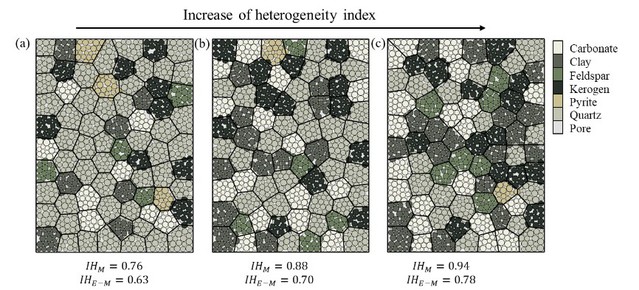Dingdian Yan a b, Luanxiao Zhao a b, Yang Wang c d, Yonghao Zhang e, Zhenjia Cai a b, Xuehang Song f, Fengshou Zhang g, Jianhua Geng a b
a State Key Laboratory of Marine Geology, Tongji University, Shanghai, 200092, China
b School of Ocean and Earth Science, Tongji University, Shanghai, 200092, China
c University of Houston, Department of Earth and Atmospheric Sciences, Houston, USA
d SINOPEC Geophysical Research Institute, Nanjing, 211100, China
e China National Logging Corporation, Xi'an, 710077, China
f CAS Key Lab of Low-Carbon Conversion Science and Engineering, Shanghai Advanced Research Institute, Chinese Academy of Sciences, Shanghai, 201210, China
g Key Laboratory of Geotechnical & Underground Engineering of Ministry of Education, Tongji University, Shanghai, 200092, China
Abstract: Heterogeneity is an inherent feature of subsurface rocks. Unconventional reservoir shales, a group of typically fined-grained sedimentary rocks, usually exhibit strong heterogeneities due to the diversity of their constituents, including stiff silicate and carbonate minerals, ductile clay minerals, and organic matter. Understanding the influence of heterogeneities on the mechanical response as well as the failure behavior of reservoir shales plays a crucial role in numerous fields of Earth and Energy sciences, such as unconventional reservoir exploration, sealing of sequestration, nuclear waste disposal, and hydrogen storage. In this study, we propose two heterogeneity indexes, intending to quantitatively characterize the heterogeneity of mineralogical compositions in unconventional reservoir shales. The first index takes into account the heterogeneity of mineral content, and the other one comprehensively considers the mineralogical heterogeneity and its corresponding mechanical properties. We apply these heterogeneities indexes to two experimental datasets of marine and lacustrine shales. The results show that the heterogeneity index significantly influences the mechanical properties and deformation behaviors of reservoir shales. As the increment of heterogeneous indexes, the ultimate strength and static Young's modulus show a general decreasing trend. However, the effect of the heterogeneity index on the static Poisson's ratio is weak. The numerical simulation results also confirm our experimental analysis, where the ultimate strength and Young's modulus of rock have a negative correlation with the heterogeneity indexes. The proposed heterogeneity indexes provide insights into understanding the mechanical behaviors and fracability assessment of reservoir shales.
Full Article:https://doi.org/10.1016/j.ijrmms.2023.105577



